Hazard Potential in Southern Pakistan: A Study on the Subsidence and Neotectonics of Karachi and Surrounding Areas
Abstract
:1. Introduction
2. Geological Background
3. Methods
3.1. ISCE
3.2. Miaplpy
3.3. Mintpy
4. Results
5. Discussion
5.1. Natural Causes
5.2. Anthropogenic Causes
5.3. Risk to Infrastructure
6. Limitations and Considerations
7. Conclusions
Author Contributions
Funding
Data Availability Statement
Acknowledgments
Conflicts of Interest
References
- Tosi, L.; Teatini, P.; Strozzi, T. Natural versus anthropogenic subsidence of Venice. Sci. Rep. 2013, 3, 2710. [Google Scholar] [CrossRef] [PubMed] [Green Version]
- Jones, C.E.; An, K.; Blom, R.G.; Kent, J.D.; Ivins, E.R.; Bekaert, D. Anthropogenic and geologic influences on subsidence in the vicinity of New Orleans, Louisiana. J. Geophys. Res. Solid Earth 2016, 121, 3867–3887. [Google Scholar] [CrossRef]
- Blackwell, E.; Shirzaei, M.; Ojha, C.; Werth, S. Tracking California’s sinking coast from space: Implications for relative sea-level rise. Sci. Adv. 2020, 6, eaba4551. [Google Scholar] [CrossRef] [PubMed]
- Huang, J.; Khan, S.D.; Ghulam, A.; Crupa, W.; Abir, I.A.; Khan, A.S.; Kakar, D.M.; Kasi, A.; Kakar, N. Study of Subsidence and Earthquake Swarms in the Western Pakistan. Remote Sens. 2016, 8, 956. [Google Scholar] [CrossRef] [Green Version]
- National Oceanic and Atmospheric Administration. What Is Subsidence? Available online: https://oceanservice.noaa.gov/facts/subsidence.html (accessed on 15 February 2023).
- Törnqvist, T.E.; Wallace, D.J.; Storms, J.E.A.; Wallinga, J.; van Dam, R.L.; Blaauw, M.; Derksen, M.S.; Klerks, C.J.W.; Meijneken, C.; Snijders, E.M.A. Mississippi Delta subsidence primarily caused by compaction of Holocene strata. Nat. Geosci. 2008, 1, 173–176. [Google Scholar] [CrossRef]
- Tessler, Z.D.; Vörösmarty, C.J.; Grossberg, M.; Gladkova, I.; Aizenman, H.; Syvitski, J.P.M.; Foufoula-Georgiou, E. Profiling risk and sustainability in coastal deltas of the world. Science 2015, 349, 638–643. [Google Scholar] [CrossRef] [Green Version]
- Buckley, S.M.; Rosen, P.A.; Hensley, S.; Tapley, B.D. Land subsidence in Houston, Texas, measured by radar interferometry and constrained by extensometers. J. Geophys. Res. 2003, 108, 2542. [Google Scholar] [CrossRef]
- Sneed, M.; Brandt, J.T.; Solt, M. Land Subsidence along the California Aqueduct in West-Central San Joaquin Valley, California, 2003–2010; U.S. Geological Survey: Sacramento, CA, USA, 2018. [CrossRef]
- Braun, C.L.; Ramage, J.K. Status of Groundwater-Level Altitudes and Long-Term Groundwater-Level Changes in the Chicot, Evangeline, and Jasper Aquifers, Houston-Galveston Region, Texas, 2020; U.S. Geological Survey: Austin, TX, USA, 2020. [CrossRef]
- Bilham, R.; Lodi, S.; Hough, S.; Bukhary, S.; Khan, A.M.; Rafeeqi, S.F.A. Seismic Hazard in Karachi, Pakistan: Uncertain Past, Uncertain Future. Seismol. Res. Lett. 2007, 78, 601–613. [Google Scholar] [CrossRef] [Green Version]
- Richey, A.S.; Thomas, B.F.; Lo, M.-H.; Reager, J.T.; Famiglietti, J.S.; Voss, K.; Swenson, S.; Rodell, M. Quantifying renewable groundwater stress with GRACE. Water Resour. Res. 2015, 51, 5217–5238. [Google Scholar] [CrossRef]
- Kasmarek, M.C.; Ramage, J.K.; Johnson, M.R. Water-Level Altitudes 2016 and Water-Level Changes in the Chicot, Evangeline, and Jasper Aquifers and Compaction 1973–2015 in the Chicot and Evangeline Aquifers, Houston-Galveston Region, Texas; U.S. Geological Survey: Austin, TX, USA, 2016. [CrossRef]
- Khan, S.D.; Gadea, O.C.A.; Alvarado, A.T.; Tirmizi, O.A. Surface Deformation Analysis of the Houston Area Using Time Series Interferometry and Emerging Hot Spot Analysis. Remote Sens. 2022, 14, 3831. [Google Scholar] [CrossRef]
- Sarwar, G. Riding the mobile Karachi arc, Pakistan: Understanding tectonic threats. J. Himal. Earth Sci. 2013, 46, 9–24. [Google Scholar]
- Quittmeyer, R.; Farah, A.; Jacob, K.H. The seismicity of Pakistan and its relation to surface faults, Geodynamics of Pakistan. In Geodynamics of Pakistan; Geological Survey of Pakistan: Quetta, Pakistan, 1979; pp. 271–284. [Google Scholar]
- Bilham, R.; Lodi, S. The door knockers of Mansurah: Strong shaking in a region of low perceived seismic risk, Sindh, Pakistan. In Ancient Earthquakes; Geological Society of America: Boulder, Colorado, 2010. [Google Scholar]
- Schelling, D.D. Frontal structural geometries and detachment tectonics of the northeastern Karachi arc, southern Kirthar Range, Pakistan. In Himalaya and Tibet: Mountain Roots to Mountain Tops; Geological Society of America: Boulder, Colorado, 1999. [Google Scholar]
- Aitchison, J.C.; Ali, J.R.; Davis, A.M. When and where did India and Asia collide? J. Geophys. Res. 2007, 112, B05423. [Google Scholar] [CrossRef] [Green Version]
- Waseem, M.; Khan, M.A.; Khan, S. Seismic sources for southern Pakistan and seismic hazard assessment of Karachi. Nat. Hazards 2019, 99, 511–536. [Google Scholar] [CrossRef]
- Lawrence, R.D.; Yeats, R.S.; Khan, S.H.; Farah, A.; DeJong, K.A. Thrust and strike slip fault interaction along the Chaman transform zone, Pakistan. Geol. Soc. Lond. Spec. Publ. 1981, 9, 363–370. [Google Scholar] [CrossRef]
- Farah, A.; Abbas, G.; Jong, K.A.D.; Lawrence, R.D. Evolution of the lithosphere in Pakistan. Tectonophysics 1984, 105, 207–227. [Google Scholar] [CrossRef]
- Sarwar, G.; Dejong, K. Arcs, oroclines, syntaxes; the curvature of mountain belts in Pakistan. In Geodynamics of Pakistan; Geological Survey of Pakistan: Quetta, Pakistan, 1979; pp. 341–350. [Google Scholar]
- Sohail, M.T.; Hussan, A.; Ehsan, M.; Al-Ansari, N.; Akhter, M.M.; Manzoor, Z.; Elbeltagi, A. Groundwater budgeting of Nari and Gaj formations and Groundwater mappning of Karachi, Pakistan. Appl. Water Sci. 2022, 12, 267. [Google Scholar] [CrossRef]
- Sarwar, G. Earthquakes and the Neo-Tectonic Framework of the Kutch-Hyderabad-Karachi Triple Junction Area, Indo-Pakistan. Pak. J. Hydrocarb. Res. 2004, 14, 35–40. [Google Scholar]
- Fattahi, H.; Agram, P.; Simons, M. A Network-Based Enhanced Spectral Diversity Approach for TOPS Time-Series Analysis. IEEE Trans. Geosci. Remote Sens. 2017, 55, 777–786. [Google Scholar] [CrossRef] [Green Version]
- Mirzaee, S.; Amelung, F.; Fattahi, H. Non-linear phase inversion package for time series analysis. In AGU Fall Meeting Abstracts; American Geophysical: Washington, DC, USA, 2019; Volume 2019, p. G13C-0572. [Google Scholar]
- Mirzaee, S.; Amelung, F. Volcanic Activity Change Detection Using SqueeSAR-InSAR and Backscatter Analysis. In AGU Fall Meeting Abstracts; American Geophysical: Washington, DC, USA, 2018; Volume 2018, p. G41B-0707. [Google Scholar]
- Yunjun, Z.; Fattahi, H.; Amelung, F. Small baseline InSAR time series analysis: Unwrapping error correction and noise reduction. Comput. Ampmathsemicolon Geosci. 2019, 133, 104331. [Google Scholar] [CrossRef] [Green Version]
- Ansari, H.; Zan, F.D.; Bamler, R. Sequential Estimator: Toward Efficient InSAR Time Series Analysis. IEEE Trans. Geosci. Remote Sens. 2017, 55, 5637–5652. [Google Scholar] [CrossRef] [Green Version]
- Ansari, H.; Zan, F.D.; Bamler, R. Efficient Phase Estimation for Interferogram Stacks. IEEE Trans. Geosci. Remote Sens. 2018, 56, 4109–4125. [Google Scholar] [CrossRef]
- Chen, C.W.; Zebker, H.A. Two-dimensional phase unwrapping with use of statistical models for cost functions in nonlinear optimization. J. Opt. Soc. Am. A 2001, 18, 338. [Google Scholar] [CrossRef] [PubMed] [Green Version]
- Ferretti, A.; Fumagalli, A.; Novali, F.; Prati, C.; Rocca, F.; Rucci, A. A New Algorithm for Processing Interferometric Data-Stacks: SqueeSAR. IEEE Trans. Geosci. Remote Sens. 2011, 49, 3460–3470. [Google Scholar] [CrossRef]
- Fialko, Y.; Simons, M.; Agnew, D. The complete (3-D) surface displacement field in the epicentral area of the 1999 MW7.1 Hector Mine Earthquake, California, from space geodetic observations. Geophys. Res. Lett. 2001, 28, 3063–3066. [Google Scholar] [CrossRef] [Green Version]
- Wright, T.; Parsons, B.; Lu, Z. Toward mapping surface deformation in three dimensions using InSAR. Geophys. Res. Lett. 2004, 31, 169–178. [Google Scholar] [CrossRef] [Green Version]
- Zhong, W.; Chu, T.; Tissot, P.; Wu, Z.; Chen, J.; Zhang, H. Integrated coastal subsidence analysis using InSAR, LiDAR, and land cover data. Remote Sens. Environ. 2022, 282, 113297. [Google Scholar] [CrossRef]
- Niamatullah, M. Structural Geometry and Tectonics of Southern Part of Karachi Arc—A Case Study of Pirmangho and Lalji Area. Search Discov. Artic. 2012, 50581, 1–26. [Google Scholar]
- Giosan, L.; Constantinescu, S.; Clift, P.D.; Tabrez, A.R.; Danish, M.; Inam, A. Recent morphodynamics of the Indus delta shore and shelf. Cont. Shelf Res. 2006, 26, 1668–1684. [Google Scholar] [CrossRef]
- Syvitski, J.P.M.; Kettner, A.J.; Overeem, I.; Giosan, L.; Brakenridge, G.R.; Hannon, M.; Bilham, R. Anthropocene metamorphosis of the Indus Delta and lower floodplain. Anthropocene 2013, 3, 24–35. [Google Scholar] [CrossRef]
- Bilham, R. Slip parameters for the Rann of Kachchh, India, 16 June 1819, earthquake, quantified from contemporary accounts. Geol. Soc. Lond. Spec. Publ. 1999, 146, 295–319. [Google Scholar] [CrossRef]
- Bagnardi, M.; Hooper, A. Inversion of Surface Deformation Data for Rapid Estimates of Source Parameters and Uncertainties: A Bayesian Approach. Geochem. Geophys. Geosystems 2018, 19, 2194–2211. [Google Scholar] [CrossRef]
- Inam, A.; Clift, P.D.; Giosan, L.; Tabrez, A.R.; Tahir, M.; Rabbani, M.M.; Danish, M. The geographic, geological and oceanographic setting of the Indus River. In Large Rivers; John Wiley & Sons, Ltd.: Hoboken, NJ, USA, 2007; pp. 333–346. [Google Scholar]
- Hassan, S.R. August Rains Flood Pakistan’s Financial Capital, Shatter Records. Reuters, 27 August 2020. [Google Scholar]
- Khan, A.; Kanwal, A. Wasi Haider Zaidi Multidimensional Approach for Groundwater Quality Assessment of Miocene Rocks: A Case Study of Gulistan-e-Johar Area, Karachi, Pakistan. Int. J. Ground Sediment Wate 2019, 6, 449–474. [Google Scholar] [CrossRef]
- Swenson, S.; Wahr, J. Post-processing removal of correlated errors in GRACE data. Geophys. Res. Lett. 2006, 33, L08402. [Google Scholar] [CrossRef]
- Grace Monthly Land Water Mass Grids Netcdf Release 5.0. Available online: https://podaac.jpl.nasa.gov/dataset/TELLUS_LAND_NC_RL05 (accessed on 16 February 2023).
- Landerer, F.; Swenson, S. Accuracy of scaled GRACE terrestrial water storage estimates. Water Resour. Res. 2012, 48, 4531. [Google Scholar] [CrossRef]
- Groundwater Woes of Sindh. Daily Times, 17 September 2018.
- Iqbal, N.; Ashraf, M.; Imran, M.; Abdul Salam, H.; Hasan, F.; Khan, A. Groundwater Investigations and Mapping in the Lower Indus Plain; Pakistan Council of Research in Water Resources (PCRWR): Islamabad, Pakistan, 2020.
- Cabral-Cano, E.; Osmanoglu, B.; Dixon, T.; Wdowinski, S.; Demets, C.; Cigna, F.; D’iaz-Molina, O. Subsidence and fault hazard maps using PSI and permanent GPS networks in central Mexico. IAHS-AISH Publ. 2010, 339, 255–259. [Google Scholar]
- Holzer, T.L.; Johnson, A.I. Land subsidence caused by ground water withdrawal in urban areas. GeoJournal 1985, 11, 245–255. [Google Scholar] [CrossRef]
- Kanwal, S.; Ding, X.; Wu, S.; Sajjad, M. Vertical Ground Displacements and Its Impact on Erosion along the Karachi Coastline, Pakistan. Remote Sens. 2022, 14, 2054. [Google Scholar] [CrossRef]
- Lodi, S.; Sultan, W.; Bukhary, S.S.; Rafeeqi, S.F.A. Liquefaction potential along the coastal regions of Karachi. J. Himal. Earth Sci. 2015, 48, 89–98. [Google Scholar]
- Amin, G.; Shahzad, M.I.; Jaweria, S.; Zia, I. Measuring land deformation in a mega city Karachi-Pakistan with sentinel SAR interferometry. Geocarto Int. 2022, 37, 4974–4993. [Google Scholar] [CrossRef]
- Bernal, L. Brownwood: Baytown’s Most Historic Neighborhood. Ph.D. Thesis, University of Houston, Houston, TX, USA, 2020. [Google Scholar]
- Ellis, J.; Knight, J.E.; White, J.T.; Sneed, M.; Hughes, J.D.; Ramage, J.K.; Braun, C.L.; Teeple, A.; Foster, L.K.; Rendon, S.H.; et al. Hydrogeology, Land-Surface Subsidence, and Documentation of the Gulf Coast Land Subsidence and Groundwater-Flow (GULF) Model, Southeast Texas, 1897–2018; Professional Paper; U.S. Geological Survey: Reston, VA, USA, 2023; Volume 1877, p. 432.

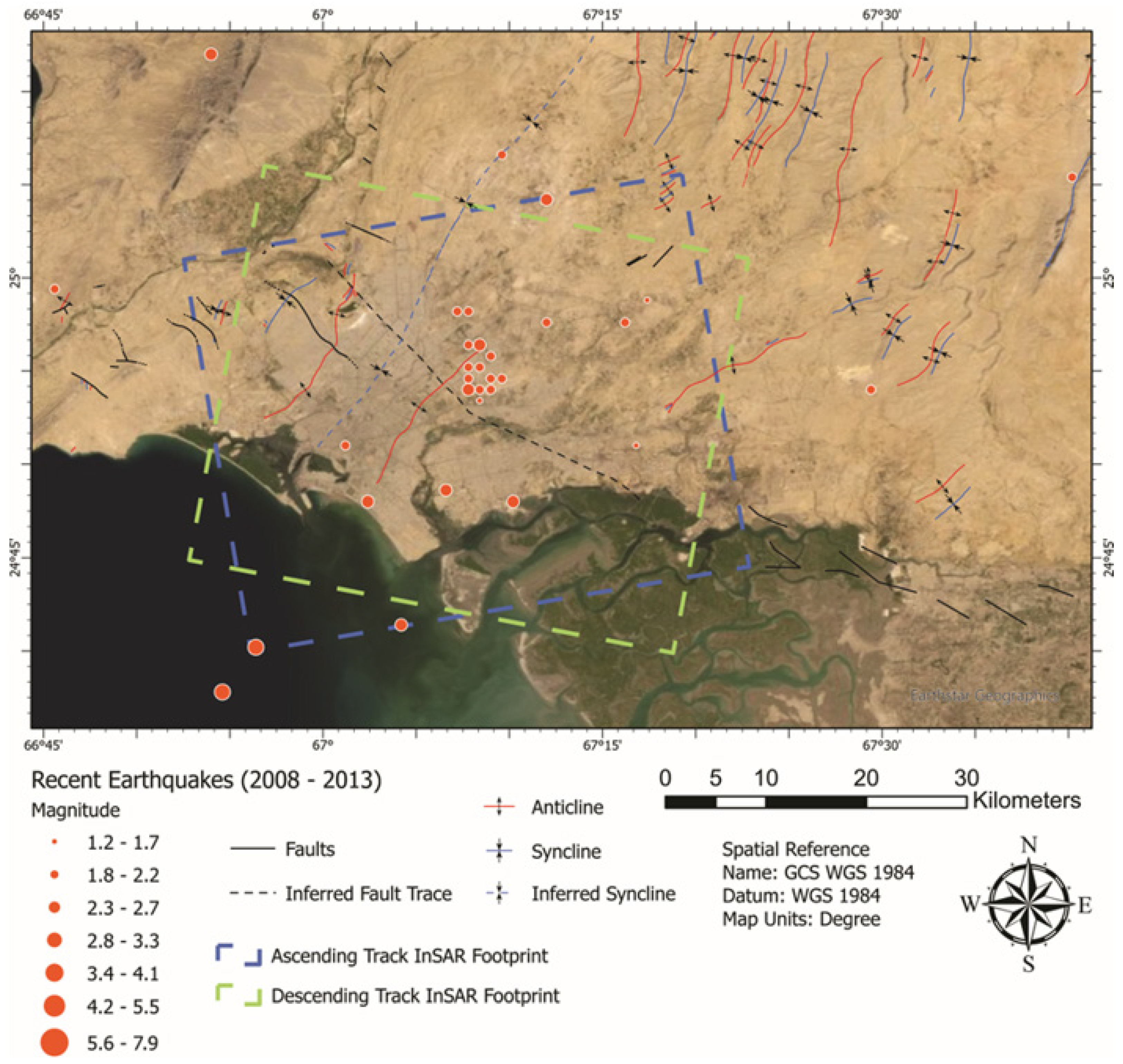
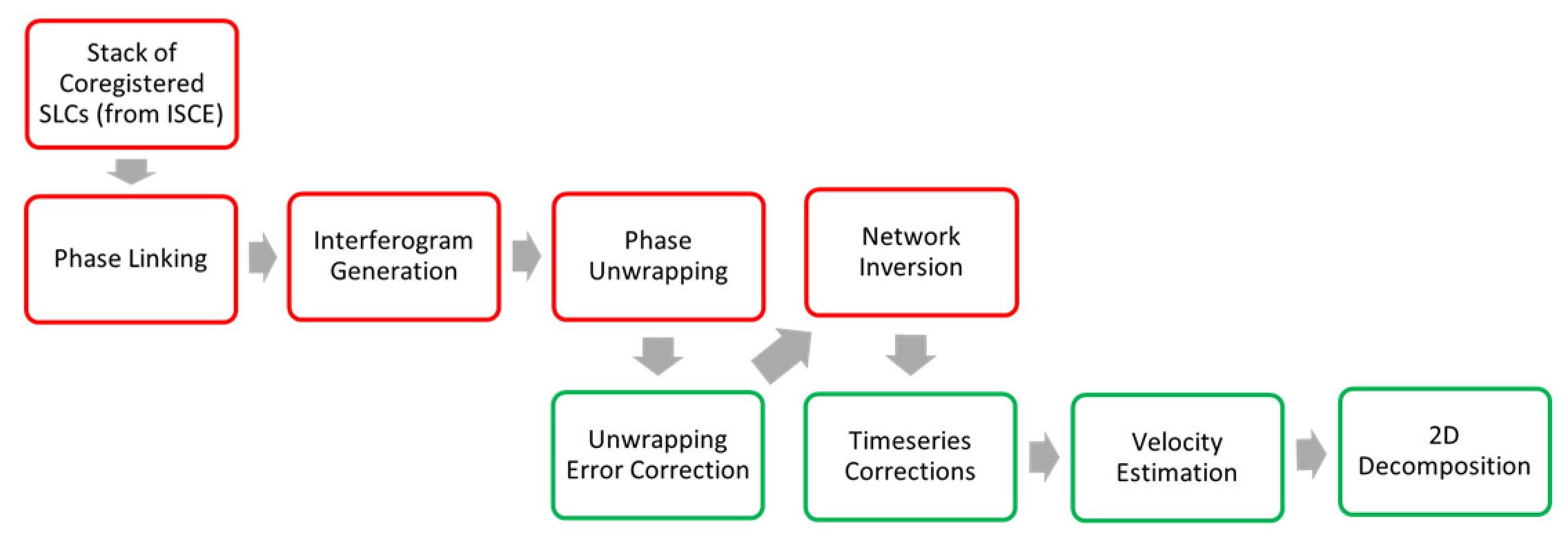
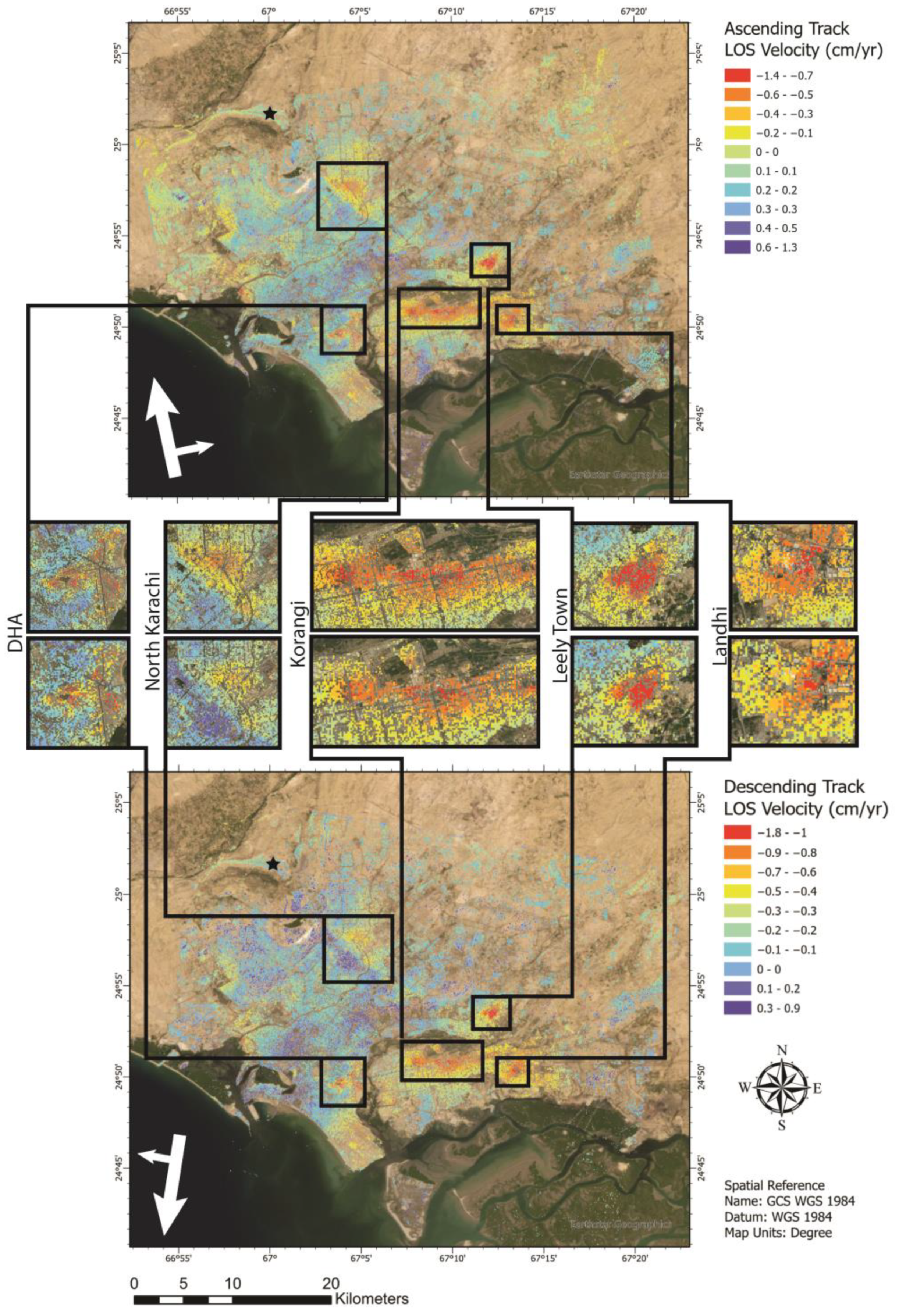
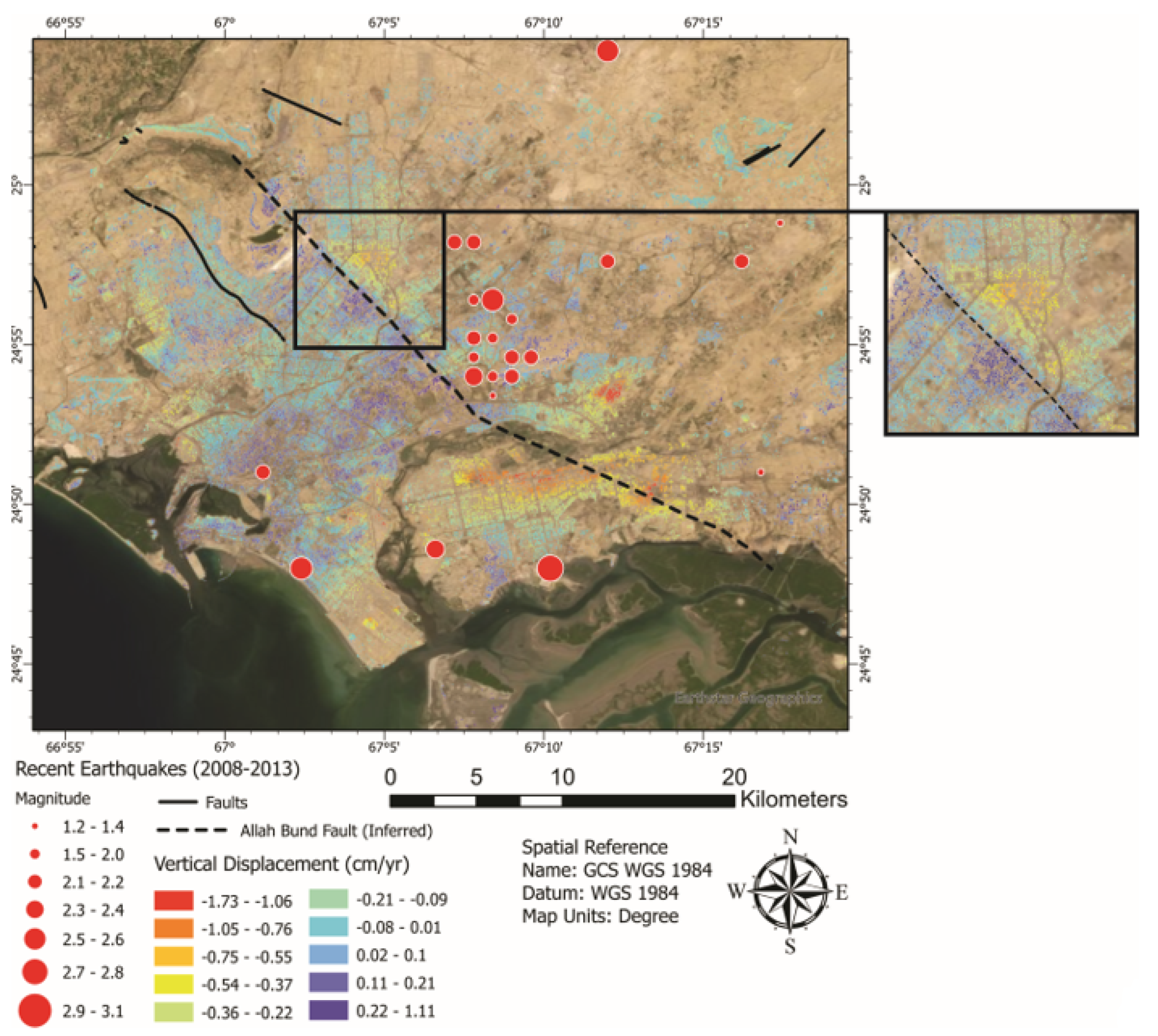
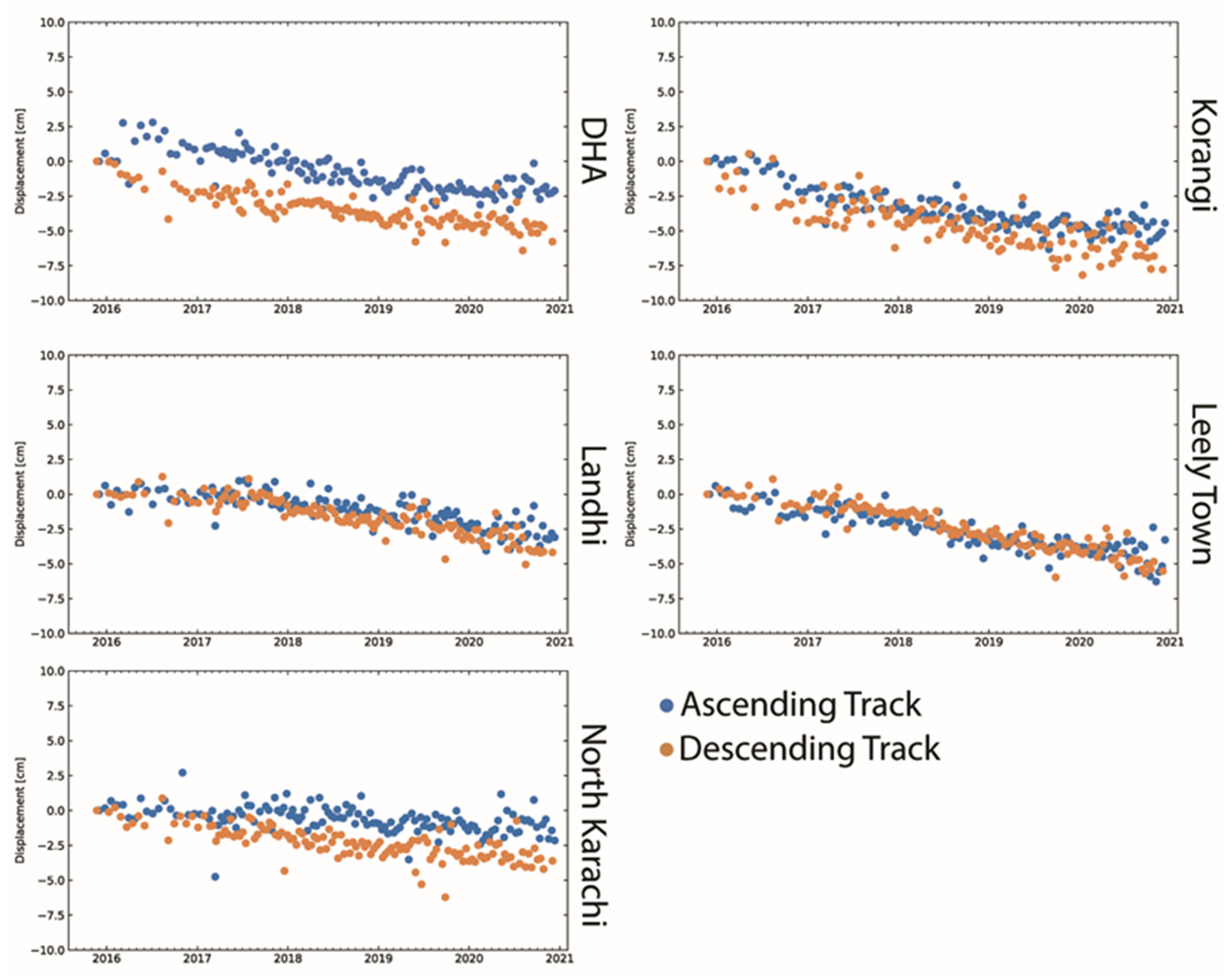
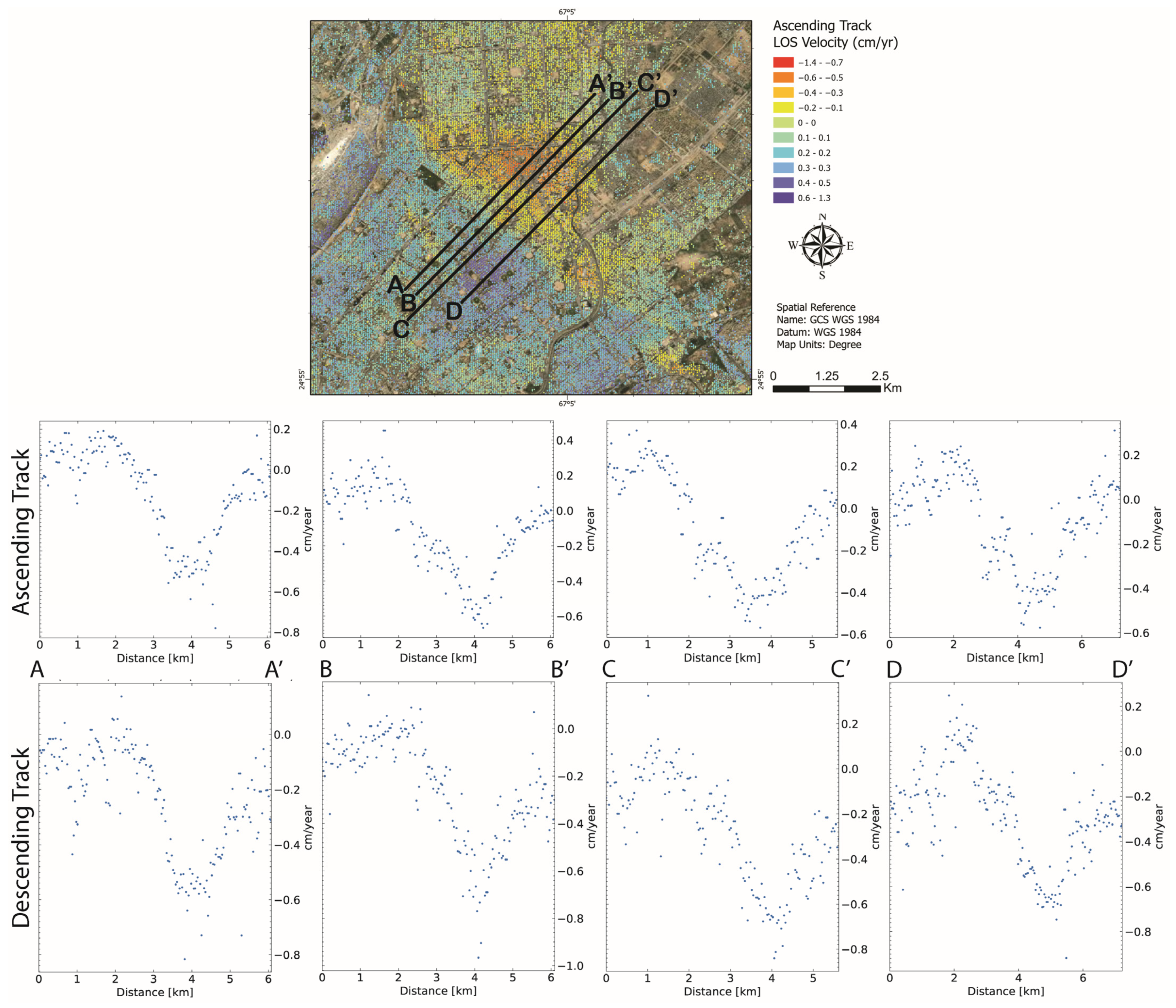
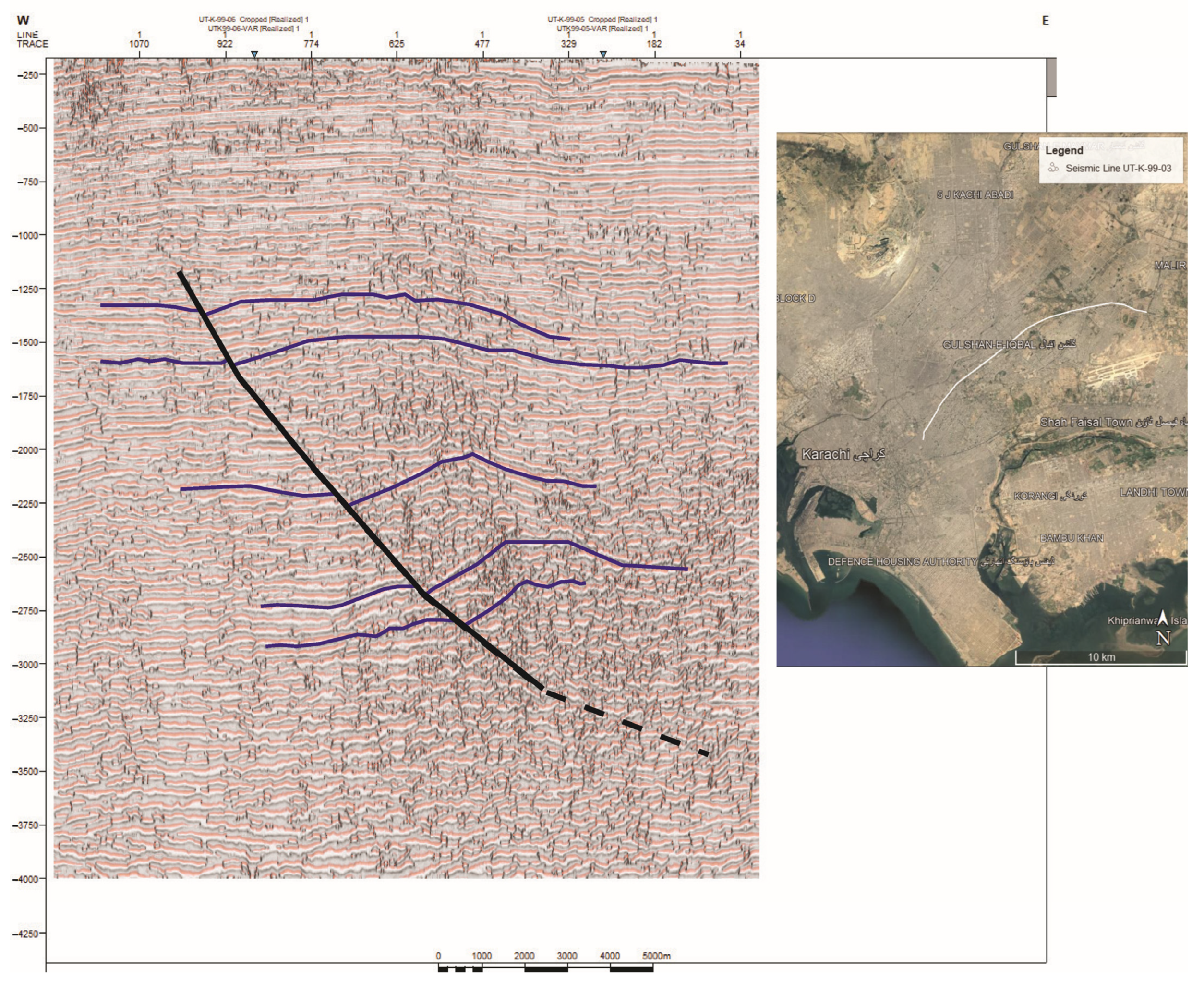
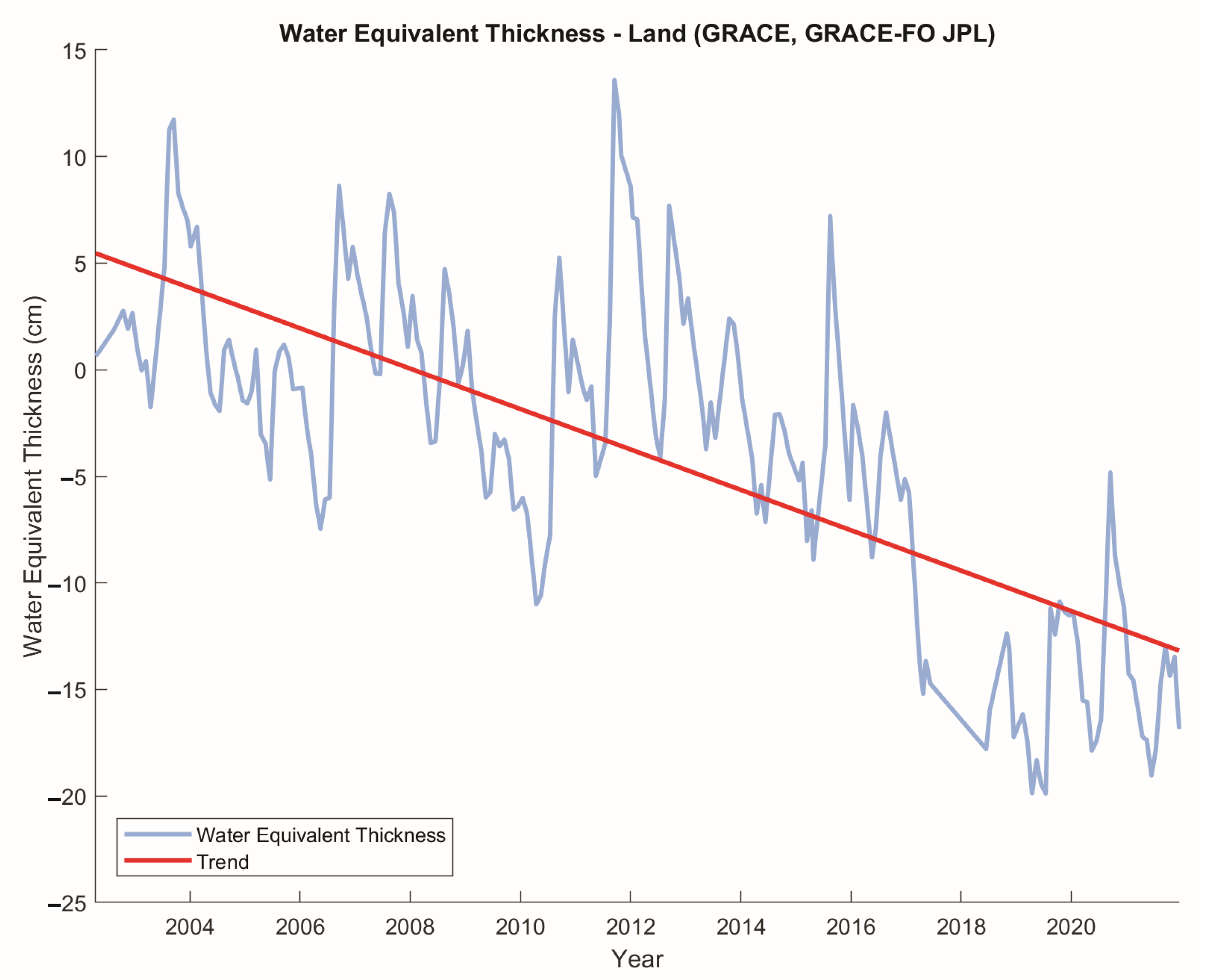

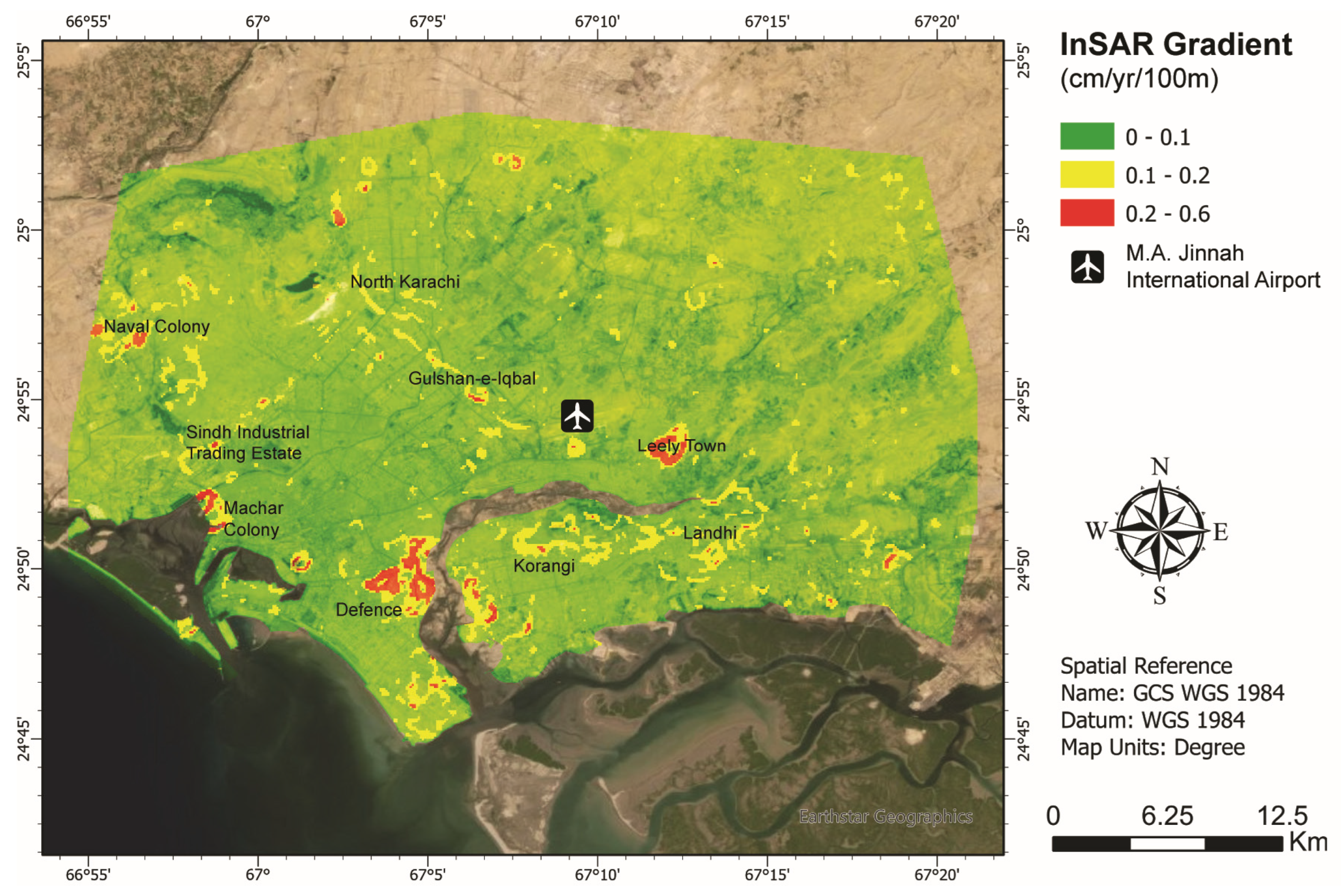
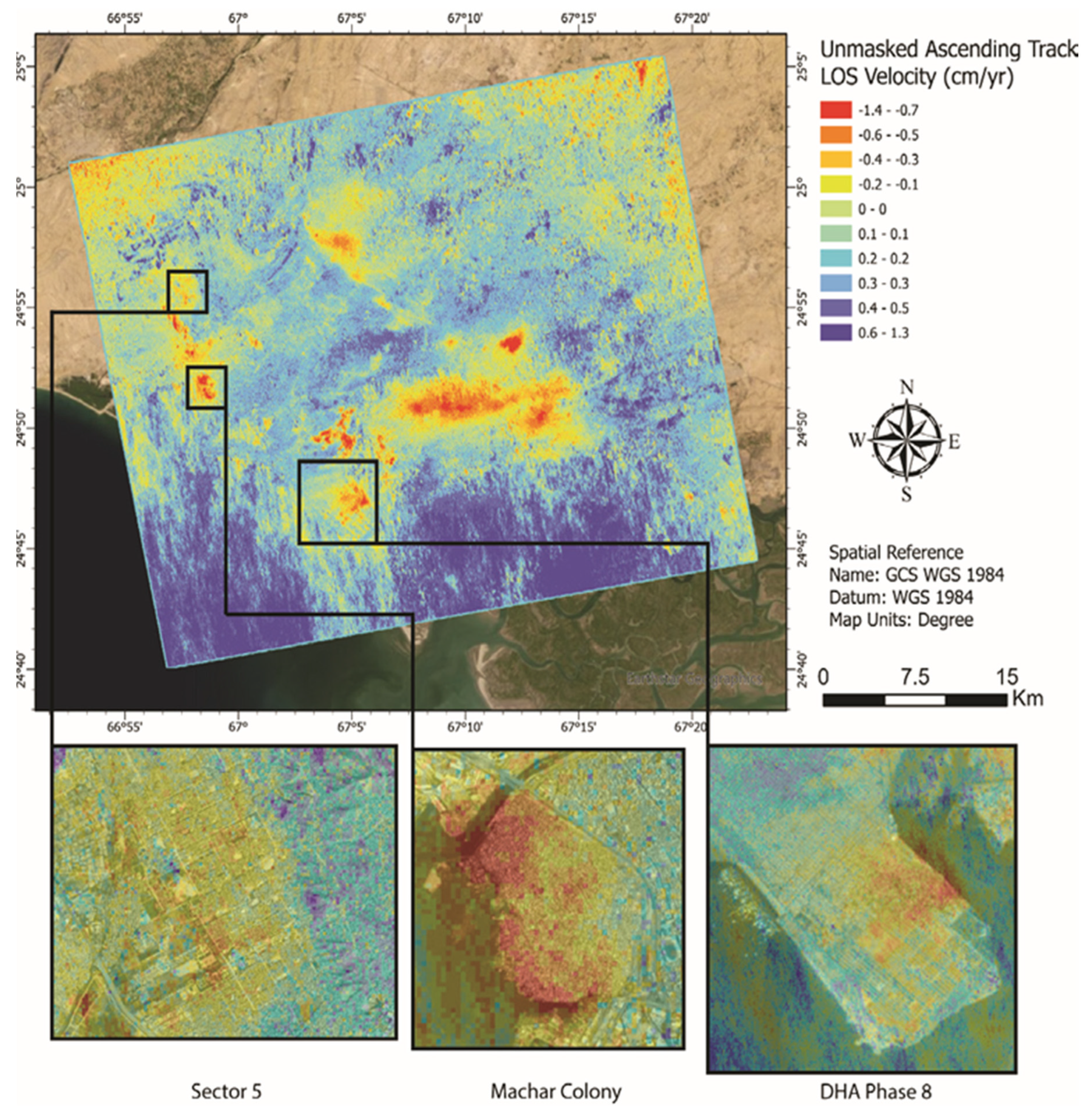
| Model Parameter | Optimal | Mean | Median | 2.50% | 97.50% |
|---|---|---|---|---|---|
| FAULT Length (m) | 1613.46 | 1604.36 | 1606.11 | 1118.21 | 2020.83 |
| FAULT Width (m) | 6607.99 | 6570.46 | 6579.03 | 6457.62 | 6663.1 |
| FAULT Depth (m) | 6346.15 | 6346.12 | 6346.15 | 6346.15 | 6346.15 |
| FAULT Dip (degrees) | 70.5215 | 70.5207 | 70.5215 | 70.5215 | 70.5215 |
| FAULT Strike (degrees) | 278.13 | 277.919 | 277.892 | 274.49 | 281.444 |
| FAULT X | 7951.54 | 7953.02 | 7949.63 | 7762.89 | 8165.05 |
| FAULT Y | −4609.78 | −4586.25 | −4591.11 | −4636.5 | −4494.37 |
| FAULT Strike Slip (m) | 0.007765 | 0.007765 | 0.007765 | 0.007765 | 0.007765 |
| FAULT Dip Slip (m) | 0.098683 | 0.105138 | 0.101016 | 0.078063 | 0.15472 |
Disclaimer/Publisher’s Note: The statements, opinions and data contained in all publications are solely those of the individual author(s) and contributor(s) and not of MDPI and/or the editor(s). MDPI and/or the editor(s) disclaim responsibility for any injury to people or property resulting from any ideas, methods, instructions or products referred to in the content. |
© 2023 by the authors. Licensee MDPI, Basel, Switzerland. This article is an open access article distributed under the terms and conditions of the Creative Commons Attribution (CC BY) license (https://creativecommons.org/licenses/by/4.0/).
Share and Cite
Tirmizi, O.; Khan, S.D.; Mirzaee, S.; Fattahi, H. Hazard Potential in Southern Pakistan: A Study on the Subsidence and Neotectonics of Karachi and Surrounding Areas. Remote Sens. 2023, 15, 1290. https://doi.org/10.3390/rs15051290
Tirmizi O, Khan SD, Mirzaee S, Fattahi H. Hazard Potential in Southern Pakistan: A Study on the Subsidence and Neotectonics of Karachi and Surrounding Areas. Remote Sensing. 2023; 15(5):1290. https://doi.org/10.3390/rs15051290
Chicago/Turabian StyleTirmizi, Osman, Shuhab D. Khan, Sara Mirzaee, and Heresh Fattahi. 2023. "Hazard Potential in Southern Pakistan: A Study on the Subsidence and Neotectonics of Karachi and Surrounding Areas" Remote Sensing 15, no. 5: 1290. https://doi.org/10.3390/rs15051290









